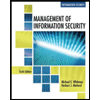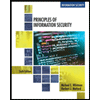
EBK COMPUTER SCIENCE: AN OVERVIEW
12th Edition
ISBN: 8220102744196
Author: BRYLOW
Publisher: PEARSON
expand_more
expand_more
format_list_bulleted
Question
Chapter 4.5, Problem 4QE
Program Plan Intro
Public-key encryption:
It is a cryptographic system that uses two keys one is the public key and the other is the secret key that is known to the recipient message. There is an element in the public-key and the private keys are related to each other such that public key is used to encrypt messages and the private key can only be used to decrypt them.
Traditional encryption:
It is a method which takes the original message and a small piece of information arrange in advance between the sender and receiver and creates the encoded version of the message.
Expert Solution & Answer
Want to see the full answer?
Check out a sample textbook solution
Students have asked these similar questions
Please answer JAVA OOP problem below:
Assume you have three data definition classes, Person, Student and Faculty. The Student and Faculty classes extend Person. Given the code snippet below, in Java, complete the method determinePersonTypeCount to print out how many Student and Faculty objects exist within the Person array. You may assume that each object within the Person[] is either referencing a Student or Faculty object.
public static void determinePersonTypeCount(Person[] people){
// Place your code here
}
Please answer JAVA OOP question below:
Consider the following relationship diagram between the Game and VideoGame data defintion classes.
Game has a constructor that takes in two parameters, title (String) and cost (double). The VideoGame constructor has an additional parameter, genre (String). In Java, efficiently write the constructors needed within the Game class and VideoGame classes.
Hint: Remember to think about the appropriate validation
In a shopping cart, there are various items, which can either belong to the category of household items or electronic items. The following UML diagram illustrates the relationship between items, household items, and electronic items.
//Implementation Class
public class ShoppingCart{
public static void main(String[] args){
final int MAX_ITEM = 50;
Item cart = new Item[MAX_ITEM];
addItem(cart); // populate the item array
printItem(cart);
}
}
Considering that all the data definition classes and the implementation class are complete, which of the following Object-Oriented Programming (OOP) concepts do you need to use in the above context?
i) Polymorphism
ii) Method Overloading
iii) Method Overriding
iv) Dynamic Binding
v) Abstract Class
Explain, using course terminology, how you would use any of the above concepts to model the given scenario.
Chapter 4 Solutions
EBK COMPUTER SCIENCE: AN OVERVIEW
Ch. 4.1 - What is an open network?Ch. 4.1 - Prob. 2QECh. 4.1 - What is a router?Ch. 4.1 - Prob. 4QECh. 4.1 - Prob. 5QECh. 4.1 - Prob. 6QECh. 4.2 - Prob. 1QECh. 4.2 - Prob. 2QECh. 4.2 - Prob. 3QECh. 4.2 - Prob. 4QE
Ch. 4.2 - Prob. 5QECh. 4.2 - Prob. 6QECh. 4.2 - Prob. 7QECh. 4.2 - Prob. 8QECh. 4.3 - Prob. 1QECh. 4.3 - Prob. 2QECh. 4.3 - Prob. 3QECh. 4.3 - Prob. 4QECh. 4.3 - Prob. 5QECh. 4.4 - Prob. 1QECh. 4.4 - Prob. 2QECh. 4.4 - Prob. 3QECh. 4.4 - What keeps a computer on the Internet from...Ch. 4.5 - Prob. 1QECh. 4.5 - Prob. 2QECh. 4.5 - Prob. 3QECh. 4.5 - Prob. 4QECh. 4.5 - Prob. 5QECh. 4 - Prob. 1CRPCh. 4 - Prob. 2CRPCh. 4 - Prob. 3CRPCh. 4 - Prob. 4CRPCh. 4 - Prob. 5CRPCh. 4 - Prob. 6CRPCh. 4 - Prob. 7CRPCh. 4 - Prob. 8CRPCh. 4 - Prob. 9CRPCh. 4 - Prob. 10CRPCh. 4 - Prob. 11CRPCh. 4 - Prob. 12CRPCh. 4 - Prob. 13CRPCh. 4 - Prob. 14CRPCh. 4 - Prob. 15CRPCh. 4 - Prob. 16CRPCh. 4 - Prob. 17CRPCh. 4 - Prob. 18CRPCh. 4 - Prob. 19CRPCh. 4 - Prob. 20CRPCh. 4 - Prob. 21CRPCh. 4 - Prob. 22CRPCh. 4 - Prob. 23CRPCh. 4 - Prob. 24CRPCh. 4 - Prob. 25CRPCh. 4 - Prob. 26CRPCh. 4 - Prob. 27CRPCh. 4 - Prob. 28CRPCh. 4 - Prob. 29CRPCh. 4 - Prob. 30CRPCh. 4 - Prob. 31CRPCh. 4 - Prob. 32CRPCh. 4 - Prob. 33CRPCh. 4 - Prob. 34CRPCh. 4 - Prob. 35CRPCh. 4 - Prob. 36CRPCh. 4 - Prob. 37CRPCh. 4 - Prob. 38CRPCh. 4 - Prob. 39CRPCh. 4 - Prob. 40CRPCh. 4 - Prob. 41CRPCh. 4 - Prob. 42CRPCh. 4 - Prob. 43CRPCh. 4 - Prob. 44CRPCh. 4 - Prob. 45CRPCh. 4 - Prob. 46CRPCh. 4 - Prob. 47CRPCh. 4 - Prob. 48CRPCh. 4 - Prob. 49CRPCh. 4 - Prob. 50CRPCh. 4 - Prob. 1SICh. 4 - Prob. 2SICh. 4 - Prob. 3SICh. 4 - Prob. 4SICh. 4 - Prob. 5SICh. 4 - Prob. 6SICh. 4 - Prob. 7SICh. 4 - Prob. 8SICh. 4 - Prob. 9SICh. 4 - Prob. 10SICh. 4 - Prob. 11SICh. 4 - Prob. 12SI
Knowledge Booster
Similar questions
- Answer this JAVA OOP question below: An Employee has a name, employee ID, and department. An Employee object must be created with all its attributes. The UML diagram is provided below: - name: String - employeeId: String - department: String + Employee(name: String, employeeId: String, department: String) + setName(name: String): void + setEmployeeId(employeeId: String): void + setDepartment(department: String): void + getName(): String + getEmployeeId(): String + getDepartment(): String + toString(): String A faculty is an Employee with an additional field String field: rank public class TestImplementation{ public static void main(String[] args){ Employee[] allEmployee = new Employee[100]; // create an employee object with name Tom Evan, employee ID 001 and department IST and store it in allEmployee // create a faculty object with name Adam Scott, employee ID 002, department IST and rank Professor and store it in allEmployee } }arrow_forwardPlease answer this JAVA OOP question that is given below: An Employee has a name, employee ID, and department. An Employee object must be created with all its attributes. The UML diagram is provided below: - name: String - employeeId: String - department: String + Employee(name: String, employeeId: String, department: String) + setName(name: String): void + setEmployeeId(employeeId: String): void + setDepartment(department: String): void + getName(): String + getEmployeeId(): String + getDepartment(): String + toString(): String A faculty is an Employee with an additional field String field: rank Assuming the Employee class is fully implemented, define a Professor class in Java with the following: A toString() method that includes both the inherited attributes and the specializationarrow_forwardPlease answer JAVA OOP question below: An Employee has a name, employee ID, and department. An Employee object must be created with all its attributes. The UML diagram is provided below: - name: String - employeeId: String - department: String + Employee(name: String, employeeId: String, department: String) + setName(name: String): void + setEmployeeId(employeeId: String): void + setDepartment(department: String): void + getName(): String + getEmployeeId(): String + getDepartment(): String + toString(): String A faculty is an Employee with an additional field String field: rank Assuming the Employee class is fully implemented, define a Professor class in Java with the following: Instance variable(s) A Constructorarrow_forward
- Develop a C++ program that execute the operation as stated by TM for addition of two binary numbers (see attached image). Your code should receive two binary numbers and output the resulting sum (also in binary). Make sure your code mimics the TM operations (dealing with the binary numbers as a string of characters 1 and 0, and following the logic to increase the first number and decreasing the second one. Try your TM for the following examples: 1101 and 101, resulting 10010; and 1101 and 11, resulting 10000.arrow_forwardI need to define and discuss the uses of one monitoring or troubleshooting tool in Windows Server 2019. thank youarrow_forwardI would likr toget help with the following concepts: - Windows Server features - Windows Server versus Windows 10 used as a client-server networkarrow_forward
arrow_back_ios
SEE MORE QUESTIONS
arrow_forward_ios
Recommended textbooks for you
 Enhanced Discovering Computers 2017 (Shelly Cashm...Computer ScienceISBN:9781305657458Author:Misty E. Vermaat, Susan L. Sebok, Steven M. Freund, Mark Frydenberg, Jennifer T. CampbellPublisher:Cengage Learning
Enhanced Discovering Computers 2017 (Shelly Cashm...Computer ScienceISBN:9781305657458Author:Misty E. Vermaat, Susan L. Sebok, Steven M. Freund, Mark Frydenberg, Jennifer T. CampbellPublisher:Cengage Learning Management Of Information SecurityComputer ScienceISBN:9781337405713Author:WHITMAN, Michael.Publisher:Cengage Learning,
Management Of Information SecurityComputer ScienceISBN:9781337405713Author:WHITMAN, Michael.Publisher:Cengage Learning, Principles of Information Security (MindTap Cours...Computer ScienceISBN:9781337102063Author:Michael E. Whitman, Herbert J. MattordPublisher:Cengage Learning
Principles of Information Security (MindTap Cours...Computer ScienceISBN:9781337102063Author:Michael E. Whitman, Herbert J. MattordPublisher:Cengage Learning Principles of Information Systems (MindTap Course...Computer ScienceISBN:9781285867168Author:Ralph Stair, George ReynoldsPublisher:Cengage Learning
Principles of Information Systems (MindTap Course...Computer ScienceISBN:9781285867168Author:Ralph Stair, George ReynoldsPublisher:Cengage Learning A+ Guide To It Technical SupportComputer ScienceISBN:9780357108291Author:ANDREWS, Jean.Publisher:Cengage,
A+ Guide To It Technical SupportComputer ScienceISBN:9780357108291Author:ANDREWS, Jean.Publisher:Cengage,

Enhanced Discovering Computers 2017 (Shelly Cashm...
Computer Science
ISBN:9781305657458
Author:Misty E. Vermaat, Susan L. Sebok, Steven M. Freund, Mark Frydenberg, Jennifer T. Campbell
Publisher:Cengage Learning

Management Of Information Security
Computer Science
ISBN:9781337405713
Author:WHITMAN, Michael.
Publisher:Cengage Learning,


Principles of Information Security (MindTap Cours...
Computer Science
ISBN:9781337102063
Author:Michael E. Whitman, Herbert J. Mattord
Publisher:Cengage Learning

Principles of Information Systems (MindTap Course...
Computer Science
ISBN:9781285867168
Author:Ralph Stair, George Reynolds
Publisher:Cengage Learning

A+ Guide To It Technical Support
Computer Science
ISBN:9780357108291
Author:ANDREWS, Jean.
Publisher:Cengage,